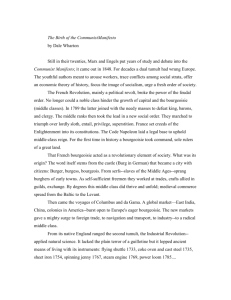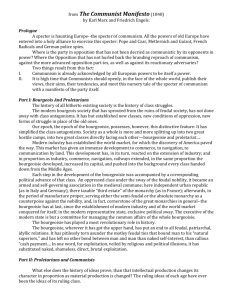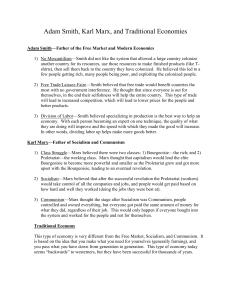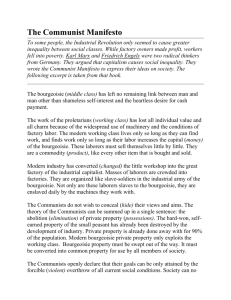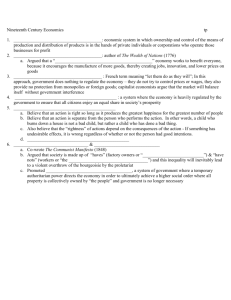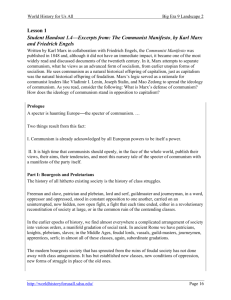The Communist Manifesto
advertisement
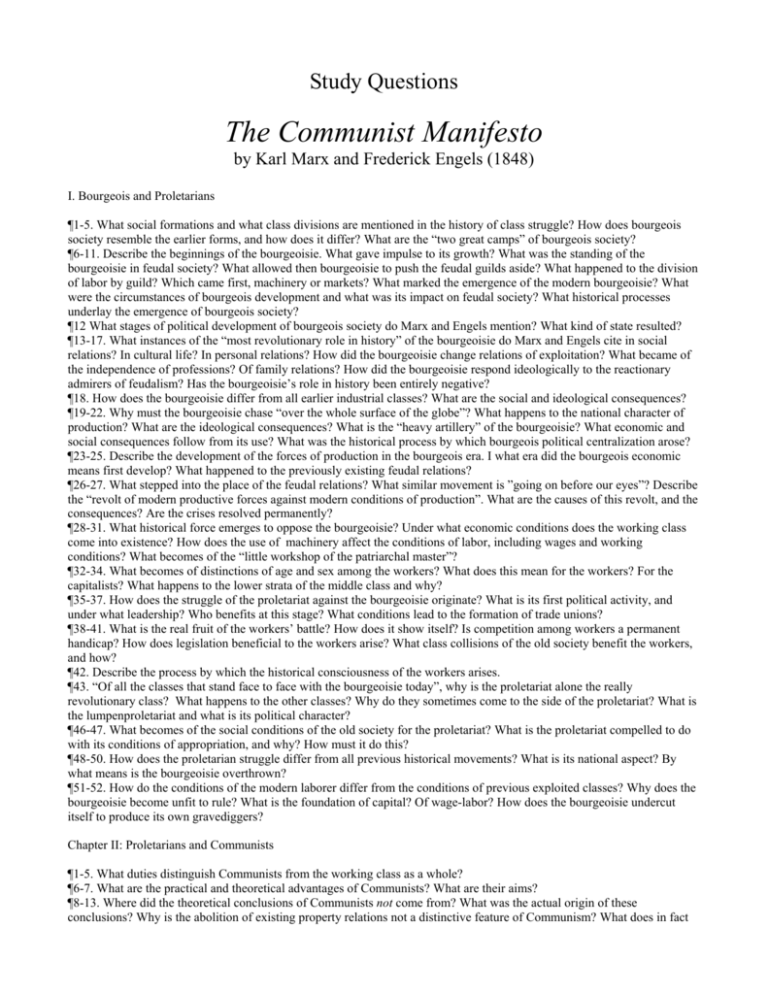
Study Questions The Communist Manifesto by Karl Marx and Frederick Engels (1848) I. Bourgeois and Proletarians ¶1-5. What social formations and what class divisions are mentioned in the history of class struggle? How does bourgeois society resemble the earlier forms, and how does it differ? What are the “two great camps” of bourgeois society? ¶6-11. Describe the beginnings of the bourgeoisie. What gave impulse to its growth? What was the standing of the bourgeoisie in feudal society? What allowed then bourgeoisie to push the feudal guilds aside? What happened to the division of labor by guild? Which came first, machinery or markets? What marked the emergence of the modern bourgeoisie? What were the circumstances of bourgeois development and what was its impact on feudal society? What historical processes underlay the emergence of bourgeois society? ¶12 What stages of political development of bourgeois society do Marx and Engels mention? What kind of state resulted? ¶13-17. What instances of the “most revolutionary role in history” of the bourgeoisie do Marx and Engels cite in social relations? In cultural life? In personal relations? How did the bourgeoisie change relations of exploitation? What became of the independence of professions? Of family relations? How did the bourgeoisie respond ideologically to the reactionary admirers of feudalism? Has the bourgeoisie’s role in history been entirely negative? ¶18. How does the bourgeoisie differ from all earlier industrial classes? What are the social and ideological consequences? ¶19-22. Why must the bourgeoisie chase “over the whole surface of the globe”? What happens to the national character of production? What are the ideological consequences? What is the “heavy artillery” of the bourgeoisie? What economic and social consequences follow from its use? What was the historical process by which bourgeois political centralization arose? ¶23-25. Describe the development of the forces of production in the bourgeois era. I what era did the bourgeois economic means first develop? What happened to the previously existing feudal relations? ¶26-27. What stepped into the place of the feudal relations? What similar movement is ”going on before our eyes”? Describe the “revolt of modern productive forces against modern conditions of production”. What are the causes of this revolt, and the consequences? Are the crises resolved permanently? ¶28-31. What historical force emerges to oppose the bourgeoisie? Under what economic conditions does the working class come into existence? How does the use of machinery affect the conditions of labor, including wages and working conditions? What becomes of the “little workshop of the patriarchal master”? ¶32-34. What becomes of distinctions of age and sex among the workers? What does this mean for the workers? For the capitalists? What happens to the lower strata of the middle class and why? ¶35-37. How does the struggle of the proletariat against the bourgeoisie originate? What is its first political activity, and under what leadership? Who benefits at this stage? What conditions lead to the formation of trade unions? ¶38-41. What is the real fruit of the workers’ battle? How does it show itself? Is competition among workers a permanent handicap? How does legislation beneficial to the workers arise? What class collisions of the old society benefit the workers, and how? ¶42. Describe the process by which the historical consciousness of the workers arises. ¶43. “Of all the classes that stand face to face with the bourgeoisie today”, why is the proletariat alone the really revolutionary class? What happens to the other classes? Why do they sometimes come to the side of the proletariat? What is the lumpenproletariat and what is its political character? ¶46-47. What becomes of the social conditions of the old society for the proletariat? What is the proletariat compelled to do with its conditions of appropriation, and why? How must it do this? ¶48-50. How does the proletarian struggle differ from all previous historical movements? What is its national aspect? By what means is the bourgeoisie overthrown? ¶51-52. How do the conditions of the modern laborer differ from the conditions of previous exploited classes? Why does the bourgeoisie become unfit to rule? What is the foundation of capital? Of wage-labor? How does the bourgeoisie undercut itself to produce its own gravediggers? Chapter II: Proletarians and Communists ¶1-5. What duties distinguish Communists from the working class as a whole? ¶6-7. What are the practical and theoretical advantages of Communists? What are their aims? ¶8-13. Where did the theoretical conclusions of Communists not come from? What was the actual origin of these conclusions? Why is the abolition of existing property relations not a distinctive feature of Communism? What does in fact distinguish Communism? What distinguishes bourgeois property? What sums up the theory of the Communists? ¶14-17. How do the bourgeoisie reproach the Communists? What happens to small private property under capitalism? What kind of property does wage labor create? What is the basis of bourgeois property? ¶18-19. Why do the authors say that capital is not only a personal but a social product? What does this imply about its conversion into social property? ¶20-23. What determines the average price of wage labor under capitalism? What aspect of the price of wage labor do the Communists intend to abolish, and why? How does the role of accumulated labor differ between bourgeois and Communist society? How else will Communism reverse the relationship between capital and labor? ¶24-28. In what sense do the Communists intend to abolish freedom and individuality? What does the bourgeois mean by “freedom”? In what sense only do the “brave words” of the bourgeoisie about freedom have meaning? Who has already done away with private property for the great majority of the population? What is the necessary condition of the form of property which the Communists want to abolish? ¶29-33. How do the authors respond to the bourgeois accusations that Communism is opposed to individuality? Of what power is the bourgeoisie to be deprived? How do the authors reply to the bourgeois claim that the abolition of private property will bring about universal laziness? ¶34-36. What objection does the bourgeois raise to “the Communist mode of producing and appropriating intellectual products”? How do the authors reply? ¶37-41. Of what selfish misconception do the authors accuse the bourgeois? How is the bourgeoisie like previous ruling classes in this regard and how does it differ? What “infamous proposal” of the Communists outrages the bourgeoisie? What is the foundation of the bourgeois family and what is its “complement”? What will happen to both? ¶42-44. What is the bourgeois objection to the Communist goal of social education and how do the authors reply? What is the real status of the “hallowed co-relation of parent and child”? ¶45-50. Why does the bourgeois see in Communism the “community of women”? What is the real point of Communism in this respect? What is the actual status of the “community of women” in bourgeois society? What must happen to this condition with the abolition of capitalist production? ¶51-55. How does the bourgeoisie reproach the Communists on the question of countries and nations and how do the authors respond? To what extent is the proletariat “national”? What is happening to national differences under the bourgeoisie, and what will happen to them under the proletariat? What stand toward national differences, conversely, must the proletariat take? How will the abolition of exploitation affect the antagonisms between nations? ¶56-60. What connection do the authors see between intellectual life and society as a whole? How do revolutionary ideas originate? What historical stages of ideological development do the authors cite? ¶61-66. How does the bourgeoisie accuse the Communists of contradicting historical experience with respect to religious, philosophical, etc., ideas? How, in response, do the authors analyze the common forms of social consciousness of past societies? Why does Communism involve the “most radical rupture with traditional ideas”? ¶67-72. What is the “first step of the revolution by the working class”? How will the working class use its political supremacy? By what means will this process begin? Describe the initial program. ¶73-74. What will happen to the public power when class distinctions have been eliminated? How will this happen? What will replace the old bourgeois society? III. SOCIALIST AND COMMUNIST LITERATURE I. Reactionary Socialism a. Feudal Socialism How did “feudal socialism” arise? What were its aims? Describe its methods and effects. What were the limitations of their understanding of history? What was their chief accusation against the bourgeoisie? What was the political practice of the feudal socialists? Describe the characteristics of Clerical Socialism. b. Petty Bourgeois Socialism What classes other than the aristocracy were ruined by the rise of the bourgeoisie? Under what circumstances did the modern petty bourgeoisie arise? What is the predicament of this class in bourgeois society? Under what circumstances did petty bourgeois socialism arise in a country like France? What criticisms of capitalism did this school of Socialism make? What are is aims and how do the authors criticize it? What did this form of Socialism come to? c. German or “True” Socialism Under what circumstances was the Socialist and Communist literature of France introduced in Germany? What did the German philosophers and would-be philosophers forget about this literature, and with what results? Of what did the work of the German literati consist? Do the authors see the German writers as higher or lower than the level of the French thinkers? What did the German writers in fact do with the French ideas, and how did they see themselves in this connection? What became of German Socialism by taking its schoolboy tasks so seriously? How was “True” Socialism taken by the parsons and absolute governments of Germany? What was the real ruling class of Germany at this time and how did “True” Socialism serve the interests of this class? In what “transcendental robe” did the “True” Socialists wrap their goods, and to what effect? What tasks did “True” Socialism perform in recognizing its true calling? 2. CONSERVATIVE OR BOURGEOIS SOCIALISM Why does bourgeois Socialism arise? Where does it get its adherents? What are the aims of bourgeois Socialism, and what does it require of the proletariat? What “more practical, but less systematic” form does this Socialism take, but with what limitations and with what aims? How does bourgeois Socialism achieve adequate expression? 3. CRITICAL-UTOPIAN SOCIALISM AND COMMUNISM Under what conditions did the earliest systems of Socialism and Communism arise, such as those of St. Simon, Owen, and Fourier? What conditions limited their views? What approaches to social change did they develop? How were they led to appeal to society at large, without distinction to class? What consequences did these limitations have for there programmatic proposals? What positive aspects did these early writings have? What was their overall character? What do the authors mean by saying that the significance of these schools “bears an inverse relation to historical development”? How do they differ from the previously mentioned reactionary Socialists? Why did they oppose all political action? IV. POSITION OF THE COMMUNISTS IN RELATION TO THE VARIOUS EXISTING OPPOSITION PARTIES What broad tasks of the Communists do the authors define? Describe some of the alliances of the time. What are some of the political guidelines that the Communists observe in their alliances? What do they constantly seek to instill into the working class at all times? What relation between the bourgeois democratic and proletarian revolutions did the authors see at the time in Germany? What question do the Communists bring to the front in every revolutionary movement? What united front do they seek to form? Describe the views and aims of the Communists!

